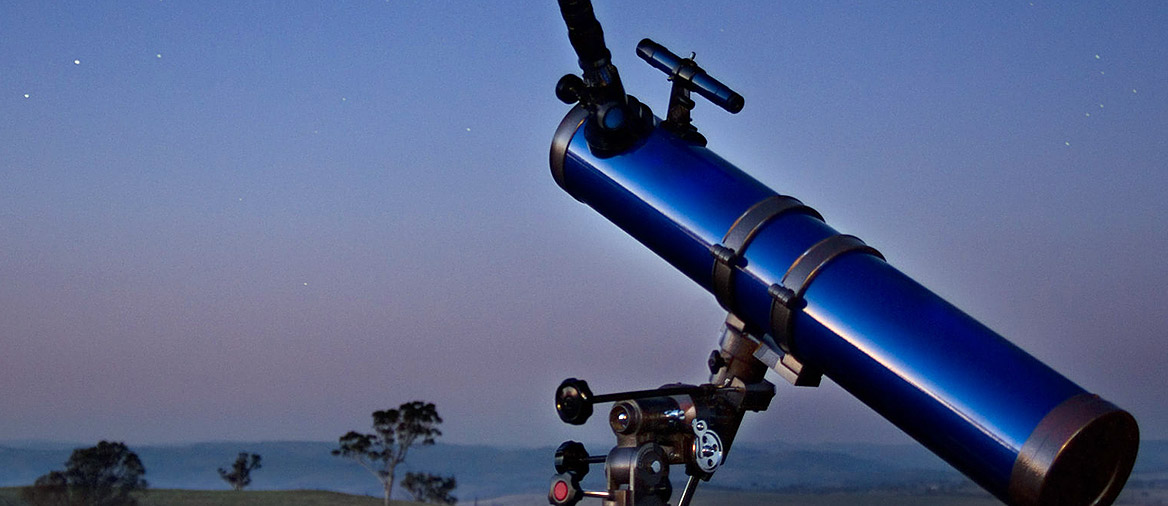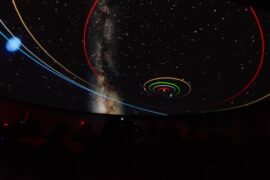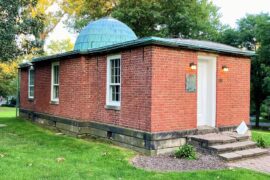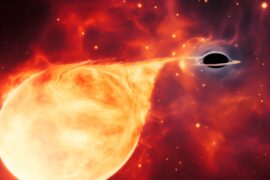One of the key technical specifications you should always consider when selecting a new telescope is its focal length. It is the second most important number for a telescope only behind the aperture. But what does the focal length really mean in a telescope and what is it? Let’s answer all those questions easily and quickly.
The focal length of a telescope is the distance the light travels inside the telescope’s tube to get from the entry point to the exit point. The entry point is the front lens, and the exit point would be the focuser, which is the part where the eyepiece goes so you can look at the image being formed.
So, if it’s the distance from entry to exit, does that mean the focal length is just the length of the telescope’s tube?
Well, that is true for some types of telescopes like refractors, however, there are more modern and sophisticated designs like Cassegrain telescopes where the light travels multiple times back and forth across the tube, extending their focal length on purpose while keeping a compact design.
The focal length is usually given in millimeters. The most common sizes for home telescopes range from 600mm for entry-level models to 2,000mm for high-end ones.
What does focal length do in a telescope?
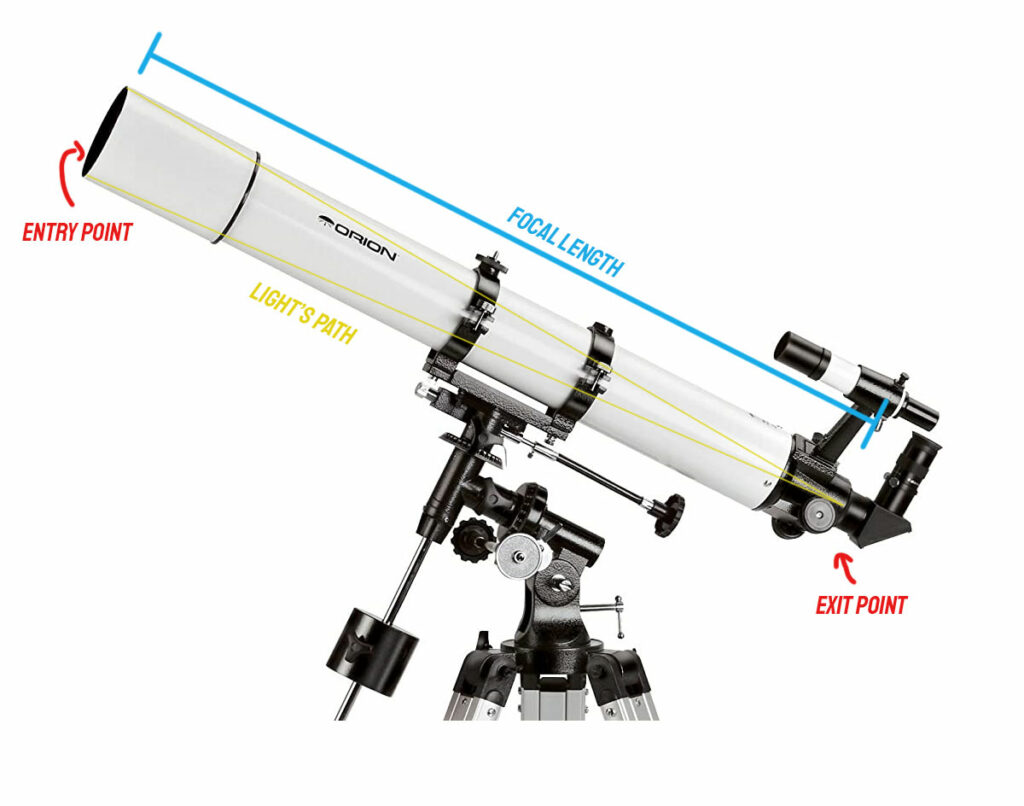
Ok, now we know what focal length is. But what does it do and why does it matter?
The mechanics of how light transmits depending on the focal length of the device are a bit complex and require a certain grade of physics knowledge so we are going to skip the details, but here’s what you need to know:
The focal length in a telescope is important because it is going to play a big part in determining two things: the magnification of the image, and the field of view.
The magnification is how much you are “zooming” into the objects you want to see through a telescope. It works just like in your phone’s camera. More magnification means more detail in the image you see, however, there is a limit at which you will not get any benefit from adding any more magnification. That limit is called maximum useful magnification and is determined by the aperture. You can get more details about that in our article explaining the aperture.
But how do you reach that magnification?
Well, the magnification of the image at any given time is determined by the following simple formula:
magnification = focal length of the telescope / focal length of the eyepiece
This means that a larger telescope focal length, increases the magnification. But the focal length of the telescope is static so the only thing you can change is the focal length of the eyepiece you are using. Because of this, it’s important to have a focal length that can fit your need from the start.
As for the field of view, it simply means how big is the observable area of the sky you can see with a telescope in degrees.
A large focal length generally means a smaller field of view. This is desirable when you want to look at the Moon, or planets. Targets where you really want to magnify as much as you want to see the details. On the other hand, a short focal length results in a larger field of view. This is ideal when you want to look at deep-sky objects like galaxies where you want to capture a larger area of the sky.
What’s the best focal length for a telescope?
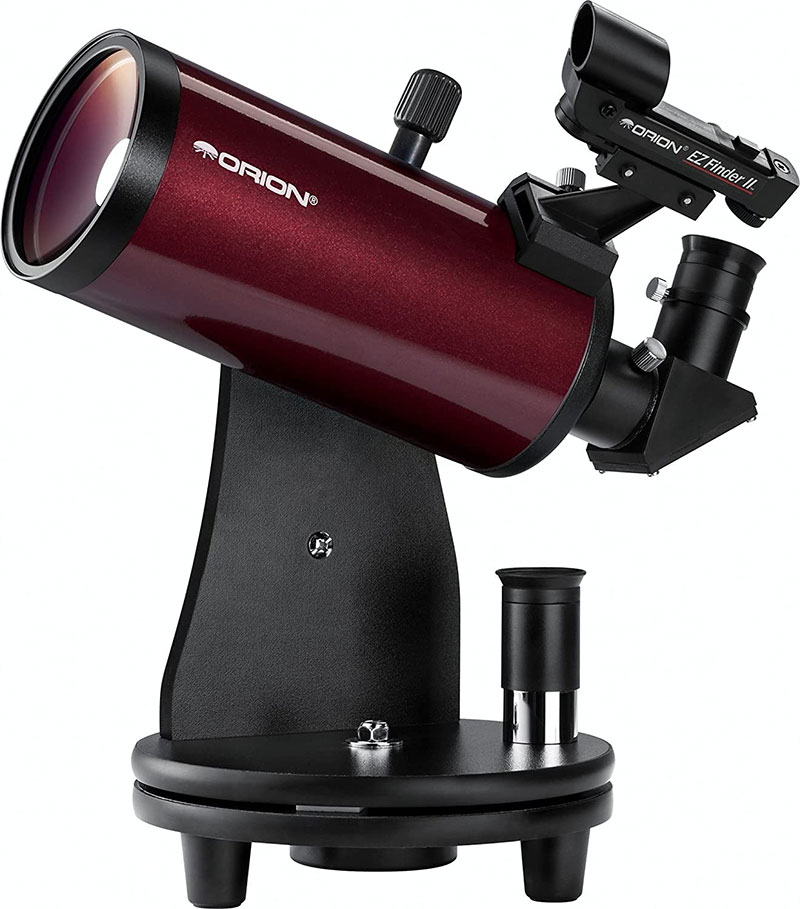
For beginner’s telescopes look for a focal length of at least 600mm. Anything less than that will limit your viewing experience too much and would only be recommended for kids’ telescopes.
Beyond that, the answer is going to depend on what type of celestial objects will be your main objective.
If you want to observe planets or the Moon in detail, go for a longer focal length.
If you want to use it for observing stars, galaxies, and nebulas, then a shorter focal length will be better.
Of course, you will be able to observe all objects in some way with all focal lengths, so don’t worry too much about it if it’s your first telescope, but do know that some objects are going to look better than others depending on your choices.
The focal length does not always increase as the aperture of some telescope models increases. There are telescopes with large apertures and smaller focal lengths and vice-versa.
Some types of telescopes will naturally have larger or shorter focal lengths, for example, refractor telescopes will generally have a lower focal length as they are limited by the length of the tube, while Maksutov-Cassegrain telescopes usually have a large focal length despite their compact design.
For astrophotography, the rules above also apply. Planets look great on longer focal lengths (1000mm+), while shorter focal lengths are better for deep-sky objects (600mm to 1,000mm)
How to increase or decrease the focal length of a telescope
Even though the focal length of a telescope is unchangeable, there are ways to artificially extend it by using certain accessories like a Barlow lens or a focal extender.
Both of these accessories are placed in the focuser and work very similarly, they increase the light transmission distance between the front lens and the eye of the user, which effectively works as if the focal length was being increased.
Barlows and extenders come in different sizes, named after the amount of increased magnification they offer, for example, 1.5x, 2x, 3x, etc.
We have a full article on Barlows and focal extenders if you want additional details.
On the other end, it is also possible to decrease the focal length of a telescope using a focal reducer. Focal reducers are simply small mirrors or lenses with positive power that decrease the focal length. The resulting focal length can be calculated by multiplying the telescope’s focal length by the focal reducer’s multiplier. For example, a telescope with a focal length of 800mm using a 0.5x focal reducer will look like a 400mm telescope.
Focal reducers can connect directly to an eyepiece or camera and are generally extremely cheap because their design is simple.
While these accessories are excellent tools that give you access to a greater range of focal lengths, you should note that every time you add one more piece to the optical chain of your telescope, some light will be lost on the way, resulting in a dimmer image, or adding small optical errors. How big that effect is will depend on the quality of the accessory.
Focal length vs aperture
There is some debate on which number is the most important specification for a telescope. Aperture or focal length?
Most astronomers agree that aperture is definitely the most relevant specification in a scope. The reason why is very simple, the aperture is going to determine the amount of light the device can capture. The more light you can capture, the better your resulting image is going to be, it is as simple as that.
On top of that, there is no way to change or play with the aperture of a telescope. What you get is unmodifiable, while on the other hand, as we mentioned above, the focal length can be artificially modified, at least up to a certain point.
Aperture is definitely the specification where you should invest most of your money when it comes to selecting a new telescope.
Conclusions
- Focal length is the distance the light travels to go from the entry to the exit point in a telescope.
- The focal length is important to determine the magnification and field of view of the resulting image.
- A long focal length is good for observing planets, a short focal length is good for observing deep space objects.
- Focal length can be artifically modified using accesories.
Enjoyed this article?
Get daily 10-minute PDFs about astronomy to read before bed!
Sign up for our upcoming micro-learning service where you will learn something new about space and beyond every day while winding down.

